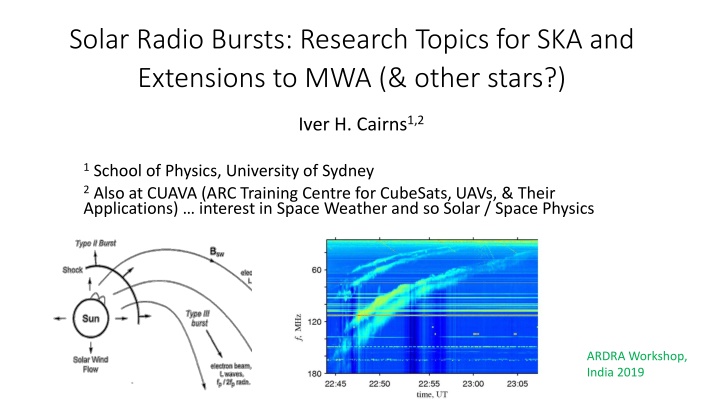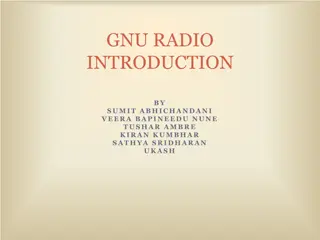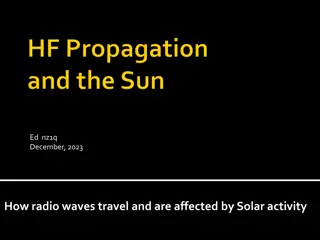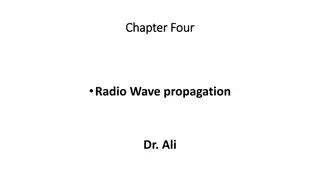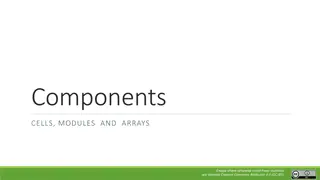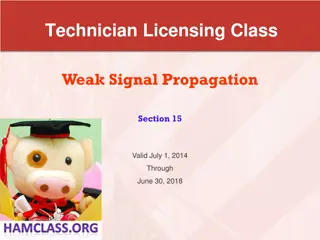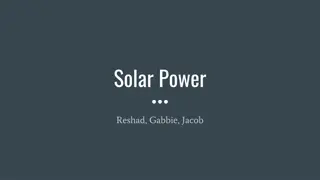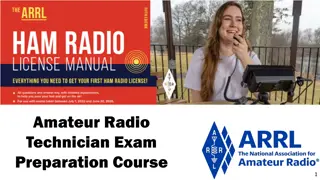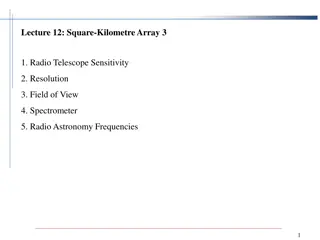Solar Radio Bursts: Research Topics for SKA and MWA
Research on solar radio bursts, particularly Type II and III bursts and Coronal Mass Ejections (CMEs), explores dynamic solar activity, fundamental physics, and their impact on space weather. Topics include density profiles, source regions, polarization, and weak radio emissions associated with CMEs, aiming to understand events likely to influence space weather on Earth. The study also delves into the potential extension of these research topics to other stars, offering insights into the physics of the corona and solar wind through radio observations.
Download Presentation

Please find below an Image/Link to download the presentation.
The content on the website is provided AS IS for your information and personal use only. It may not be sold, licensed, or shared on other websites without obtaining consent from the author.If you encounter any issues during the download, it is possible that the publisher has removed the file from their server.
You are allowed to download the files provided on this website for personal or commercial use, subject to the condition that they are used lawfully. All files are the property of their respective owners.
The content on the website is provided AS IS for your information and personal use only. It may not be sold, licensed, or shared on other websites without obtaining consent from the author.
E N D
Presentation Transcript
Solar Radio Bursts: Research Topics for SKA and Extensions to MWA (& other stars?) Iver H. Cairns1,2 1School of Physics, University of Sydney 2Also at CUAVA (ARC Training Centre for CubeSats, UAVs, & Their Applications) interest in Space Weather and so Solar / Space Physics ARDRA Workshop, India 2019
Outline 1. Intro to CMEs and Type II & III Solar Radio Bursts 2. Topics: Some Illustrations with MWA data Density profiles Multiple source regions: type IIs, IIIs, & split-bands Scattering by density irregularities Polarization Weak radio emissions associated with CMEs Tests of theory Signatures of events likely to cause space weather at Earth 4. Summary
Type II & III Bursts and CMEs [Wild & McCready, 1950; J.Kennewell, 2006] Coronal and interplanetary type II bursts Probe dynamic activity, fundamental physics (magnetic reconnection, wave processes, emission, shocks, CMEs...), ne, Te, Ti profiles, origin & heating of corona & solar wind.
CMEs & Type II and III Solar Radio Bursts arguably three of the most impressive forms of solar activity [NASA / CDAW, courtesy N. Gopalswamy et al ]
CMEs, Type II Bursts, and Space Weather Space weather = conditions in space that may affect human systems & activities on Earth & in space. 90% of large space weather events at Earth due to CMEs with southwards Bz & associated magnetic reconnection [Richardson et al., 2010]
2. Issues & Illustrations with MWA Density profiles Multiple source regions: type IIs, IIIs, & split-bands Scattering by density irregularities Polarization Weak radio emissions associated with CMEs Tests of theory Signatures of events likely to cause space weather at Earth Other stars?
Density profiles: Offset Power-law fits well probe physics of corona & solar wind . and radio bursts! Is the power-law index different before and after flares? Ducting & scattering less important? Traditional density models are poor but Offset Power-Law fits well (r variation, solar wind acceleration) [Harding et al., ApJ, 2019]
Type IIIs: Multiple sources Multiple sources & connection to magnetic geometries and scattering Sources splitting & moving at same and different f source physics, B(r) geometry, & probe of scattering . Do multiple, smaller sources exist? [McCauley et al., ApJ, 2017] Need better measurements.
Source location & scattering . polarisation Source location Density model & scattering / ducting Polarisation has information on wave physics, fundamental / harmonic, & scattering Need better measurements. [McCauley et al., 2017; Rahman et al., sub., 2019]
Type III source area & scattering? Measured A = a f-2.4 0.4 Scattering theory A = a f -4 theoretical problem. Magnetic field divergence with small amount of scattering? Multiple sources? measurements. Need better [M.M. Rahman, PhD thesis, sub., 2019]
Multiple source regions & theories for split-bands in Type II bursts? Fundamental and harmonic bands split into 2 with a gap between. 3 theories proposed: Split-bands are 1. from regions with different densities and so fp and 2fp [McLean, 1967]. 2. From upstream & downstream of shock, with frequency ratio giving the shock compression [Smerd et al., 1975]. 3. Due to two different emission mechanisms, with splitting of fce / 2 and fce for fp & 2fp radiation [Cairns, 1994]. Simulation code does not allow downstream emission and has 1 mechanism for each of fp & 2fp radiation. Thus data-simulation comparisons strong test of all three theories.
Theory / data (Learmonth) comparison: same scales 102 Flux 1 (SFU) 10-2 Frequency (MHz) 102 Calibration by J. Harding in 2014 25 40 10 Flux (SFU) 60 80 100 1 7 Sept 2014 Type II Burst 10-1 140 10-2 180 0150 0200 0210 0220 0230 [Cairns et al., in prep., 2019] Time (HHMM)
Data Simulation Comparison: 7 September 2014 Split-band Event Our simulations agree very well with the observations in frequency, intensity, & time. Strong evidence for type II theory Split-bands predicted & observed strong evidence for McLean [1967] theory. [Cairns et al., in prep., 2019]
Predicted and MWA-Observed Source Locations (a) Density and (b) de Hoffman Teller speed over shock surface Sun s limb clear gradients in density Density variations (c) Volume emissivity near shock surface for fundamental (red) & Harmonic (black) emission 2 sources with different frequencies split-bands have different source regions F & H sources overlie for this event. (d) line-of-sight integrated source region of upper harmonic split-band Two sources Nose = lower split-band Flank = upper split-bands F (red) & H (black) almost same sources [Cairns et al., in prep., 2019] Need better measurements.
Source Locations: Excellent MWA Theory Agreement Sun s limb Predicted and observed locations agree well for lower fundamental split-band (etc.) Larger observed source - due to scattering? Small role here for ducting, and propagation effects. Observed MWA source Is this usual? Predicted lower fp split-band convolved with MWA beam Need better measurements. B lines (black) Shock normal (red) [Cairns et al., ... in prep.]
4. Summary Many important problems for SKA and MWA to solve in Solar Radiophysics Density profiles & their variations with solar activity Existence or not of multiple source regions for type II & III bursts and their fine structures (e.g., split-bands) How important are scattering & ducting by density irregularities? What are the polarization properties of type II and III bursts on short timescales and do their spatial variations show coherent patterns? Tests of theory for type II and III bursts etc Weak radio emissions associated with CMEs (not discussed) Can we use the radio emissions as harbingers of CMEs & space weather at Earth ( )? Other stars? Need better measurements (esp. angular resolution) to resolve these questions observationally SKA or MWA+?
3.1 Reminder of the Simulation and Theory Approach [cf. Schmidt & Gopalswamy, 2008] We use the SWMF / BATS-R-US code (3D MHD + radiation 2012 version) 1. to model realistic corona for the time period. 2. simulate CME initiation and propagation. [Roussev et al. 03, 04, Toth et al., 2012]: Kinetic type II theory 1. Shock & plasma characteristics from BATS-R-US 2. electron energization at shock 3. Langmuir waves and radio emission. [Schmidt & Cairns, JGR, 2012a,b] Compare theory and observations. For interplanetary type IIs [Schmidt et al., ApJL, 2013; Schmidt & Cairns, JGR, 2014a,b, 2016,2017 etc.]
Type II Theory: Type II Theory: shock + plasma emission Vc = Vsh sec bn [Wild, 1952; Nelson & Melrose, 1985; Cairns, 1986, 1988; ] Semi-quantitative, analytic, macroscopic theory exists: [Knock et al., 2001, 2003a,b; Cairns et al., 2003; Kuncic et al., 2002, Knock & Cairns, 2005; Schmidt & Gopalswamy, 2008; Schmidt & Cairns, 2012a,b]
